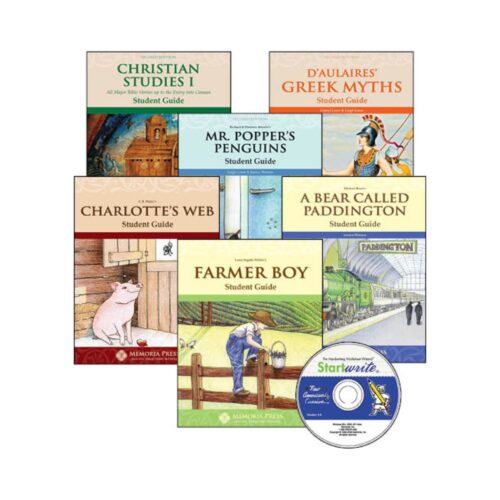
Classical education is a new term for an old path. Over the last several years it is being rediscovered. It’s the classic path, the path that was well travelled but somehow our adventurous natures took us beyond that path. As we try to rediscover how our Western Culture gave us a richness of beauty, truth and goodness that we have not been able to replicate in recent years, it turns out we’re in for a bit of a journey. This journey is presented in many different ways, styles and methods. Classical Education: Way Back When I’d like to take you back to a time before the phrase “classical education” emerged. Way back to the time when communication between human beings was primarily oral, or speaking. Some people were beginning to create systems of writing where words could be put down in a concrete, tangible ways. But it was not easy to do, so only the most important, or valued words were set down in a way that could exist outside of the human mind. Many of the texts that we have from that beginning are a good source for us to learn about who we are as human beings, but also how human beings have behaved and how or if that has changed. We need to pay special attention to some of the civilizations that existed before the birth of Christ such as the Greek, Roman, and Jewish cultures. These are three cultures whose words were put in written form and passed through the ages. When we take a closer look we will see that, as some of the first recorded thinkers, they presented foundational truths that have been built upon. To be fair, it’s not easy to take a few thousand years of history and boil it down to into a neat little summary. However, like a valiant student of the subject who can’t always distinguish between brash and brave, I’ll delve in with you and take to heart what G.K. Chesterton said: “If a thing is worth doing, it’s worth doing badly.” And I believe so strongly that it’s worth learning about our past because I believe that there is no other way to change our future. So let’s give this a try. Some Truth and Good Ideas The Greek civilization was keen to look at man as more than a physical phenomenon. Through the works of Plato we learn that man is more than a body; more than what is visible to the eye. Plato tells us about another part of man which we know to be the soul. He goes on, at tedious length I might add, to discuss what that means, and how a man can take control of his actions and become self-governed. He explains to us that to become more human, man must learn to conduct himself in a way that benefits the greater good, and the wider community of mankind. While all these ideas resonate with us, we feel something lacking. That’s because there was a major piece missing in Greek thought which became evident when, despite their efforts to be man in perfection, they were invaded by a barbarian horde who became their rulers. Some of the barbarian hordes listened to the ideas that the Greeks had put forward, and these ideas resonated with them too. As a result, they tamed their wild natures to be able to get along for the greater good of the community, or you could say they learned to be civil. And thus, we come to one of history’s greatest civilizations, the Roman Empire. The Greek ideas became the teachers in this new order, and the idea of a self-governed man became alive as the civilization began to set up structures to rule over other people. The self-governed man was learning to rule as a governor of many men, but also how to live under a governor or many governors as good citizens. As a result of their thoughts and actions, they were able to extend their rule over less governed people and barbarians became civilized. An Unavoidable Problem As lovely as it might sound, this was not the utopia that man was longing for. Self-government and learning to live under man’s rule as a good citizen did not work out the way it had been planned. While many Romans were courageous and lived honorable lives, there were many cowardly and dishonest Romans. So it’s fair to ask the question: if these ideas are so great why was Greece conquered? Why did Rome fall? Because man cannot be the perfectly self-governed individual. We know that this is true because before Plato ever drew breathe, a man named Moses lived. He was the leader of a small tribe of ex-slaves, wandering like nomads in the desert. Moses famously ascended a mountain to receive instruction from his God, the great YHWH. Moses received the powerful words spoken and etched into stone by YHWH for all the world to read: the two stone tablets of the law. He presented these words to his people and they scorned him. This Moses, beloved of YHWH, receiver of these great words was unable to contain his fully human anger towards the people. According to his God, the great YHWH that was the point. YHWH had been saying for many generations that His people could not keep these laws. But that didn’t stop Him from presenting the law to His people anyway, even after Moses destroyed the first copy deciding that the people were not worth of these great words. Jesus is the Answer So it was no small matter that, at the height of the Roman Empire, during the reign of one of Rome’s greatest governors, or Emperors, YHWH fulfilled his promise to take matters into His own hands and make everything right. He became man, in the form of a small baby, born in backwoods Jerusalem, far from the glory of Athens or Rome. This God-Man was to be the
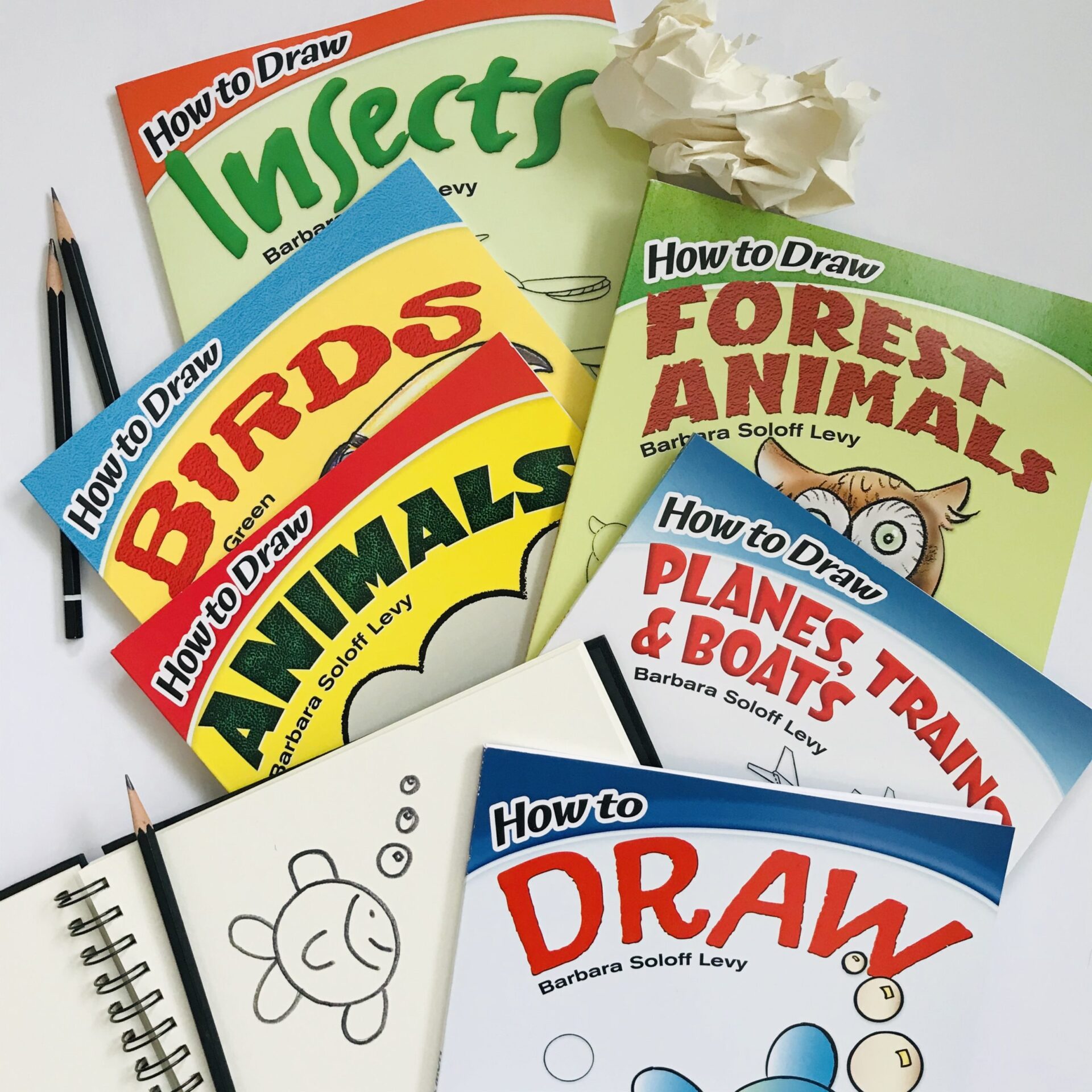
These drawing books are simple and fun. There are no written instructions, making these books a great starting point for young artists. Older artists, like, ahem, mom really appreciate these books too; they sure help with the skills that make Nature Studies more fun. Drawing books also make great additions to Morning Time. These books include practice pages but I prefer to pick up a sketchbook for each child to use just during Morning Time. It’s so fun for them to flip back and see the progress that’s been made. How to Draw Insects How to Draw Birds How to Draw Animals How to Draw Forest Animals How to Draw Planes, Trains, and Boats How to Draw by Adrianne Curwen Adrianne is a wife to a public-school educator/administrator and a homeschooling Mama to seven children, ranging in age from 7 to 23. She believes that we have a unique opportunity as homeschoolers to design individualized education that suits giftings, interests, and passions. She and her husband have used a blend of registered homeschooling, enrolment with independent DL schools, and participation in public trade school programs to design individualized programs for their children. She is passionate about using as many read-alouds, picture books, novels, and conversations to educate her children but also gets excited by the amazing homeschool-designed curriculum that’s out there. Adrianne is thrilled by her new role as Communication Specialist for Classical Education Books and is grateful to have an opportunity to learn something new. She is grateful, every day, for her saviour, Jesus Christ, and has no greater joy than when she sees her most important missions field walk with Him.
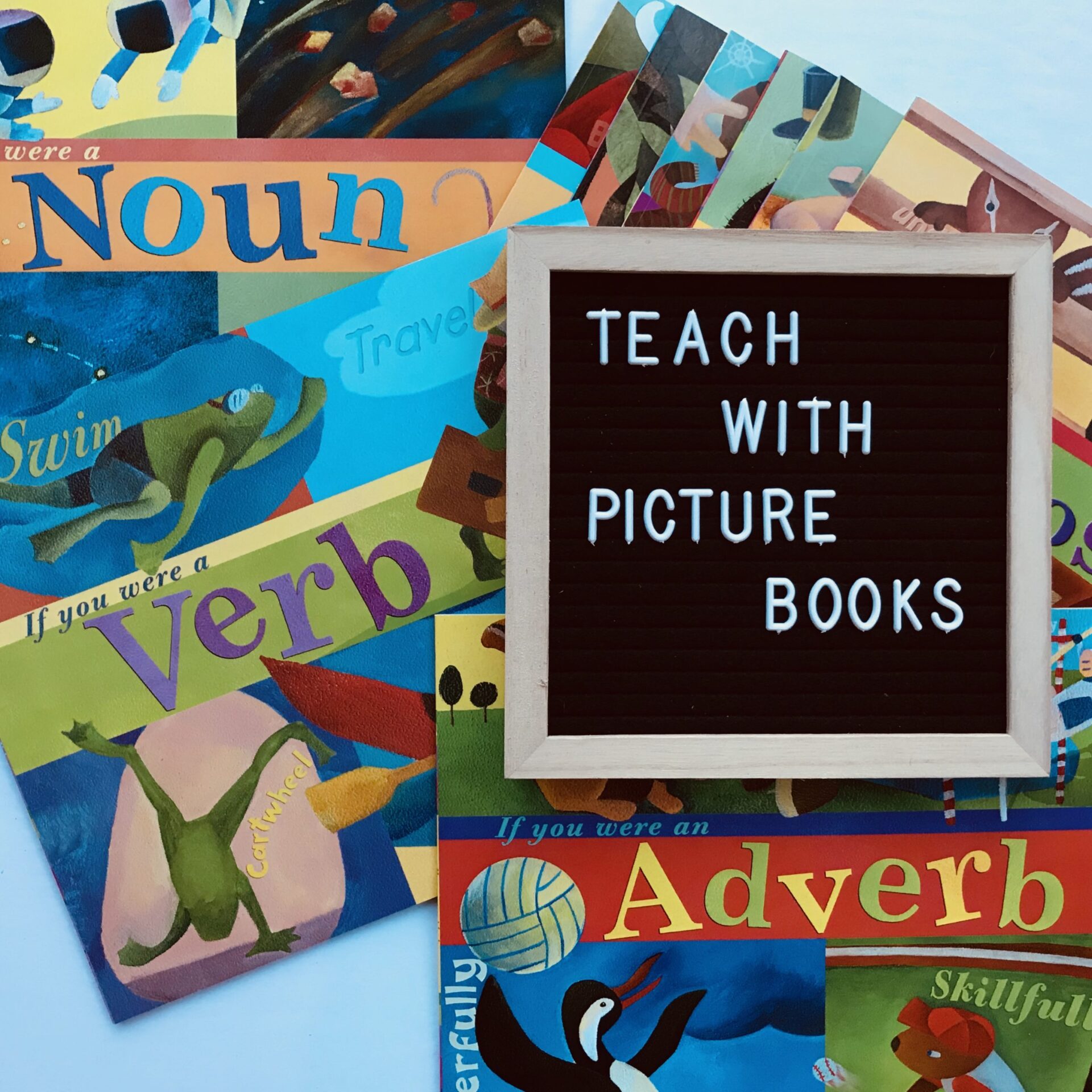
Picture books are a wonderful way to introduce your children to all kinds of topics. The selection of quality picture books is amazing and reading aloud to your children is such a natural and gentle way for your children to learn. I can’t encourage you enough to be purposeful in carving out a designated read-aloud time every day. If Morning Time or a Morning Basket is already a part of your regular routine, these should be in there! (If you are not familiar with the concept of a Morning Basket, click here to link to a short video that will help you get started.) Cycling through these stories throughout the year will give your young children a solid grasp of basic grammar. My 7-year-old, who has not been introduced to any grammar concepts yet, had a clear understanding of nouns after the first read-through, and even my 9-year-old who has completed 2 years of formal grammar curriculum enjoyed these books. There is a suggested game at the end of each book that is simple and fun. Don’t dismiss big kids before you read one of these to a younger one; they work well as a simple review, and I found that my young ones enjoyed having the big ones participate in the game. Order a few to get started with but you’ll probably be back for more. If You Were a Noun If You Were an Adjective If You Were a Verb If You Were an Adverb If You Were a Preposition If You Were an Interjection If You Were a Conjunction If You Were a Homonym or a Homophone If You Were an Antonym by Adrianne Curwen Adrianne is a wife to a public-school educator/administrator and a homeschooling Mama to seven children, ranging in age from 7 to 23. She believes that we have a unique opportunity as homeschoolers to design individualized education that suits giftings, interests, and passions. She and her husband have used a blend of registered homeschooling, enrolment with independent DL schools, and participation in public trade school programs to design individualized programs for their children. She is passionate about using as many read-alouds, picture books, novels, and conversations to educate her children but also gets excited by the amazing homeschool-designed curriculum that’s out there. Adrianne is thrilled by her new role as Communication Specialist for Classical Education Books and is grateful to have an opportunity to learn something new. She is grateful, every day, for her saviour, Jesus Christ, and has no greater joy than when she sees her most important missions field walk with Him.

The Zeezok Music Appreciation program comes in many pieces and the program is so versatile. My favorite thing about this program are the books about the composers. These books, by Opal Wheeler, are living books at their best. Each story is captivating and some of them include short pieces of music that a young aspiring musician can try to play on a keyboard or piano. With details about their character and life, these are read-alouds that are the perfect addition to your morning basket. They are about a grade 3 reading level so they can also be used for independent reading. But you don’t need to just read the books and plink out the tunes on your own. You can also purchase a thumb drive that contains all the music referred to in each book. And if that wasn’t enough, you can purchase a Student Activity Book, a Coloring book, and another thumb drive with files to create a lapbook. The question is, how much is too much? Well, how much time do you want to spend studying music? I have been teaching through the Student Activity Book One. It contains about 4 lessons for each reader. The lessons repeat their content for each reader, so you know what to expect. Each set of lessons starts with comprehension questions, a lesson that points out good character traits shown by the composer, and some activities like mapping the composer’s travels, or recipes to make food from their time and culture. It spends time talking about music theory and music styles because there is a difference between classical and baroque music. It introduces the instruments of the orchestra as well as how different kinds of orchestras are arranged. The Student Activity book is quite an in-depth study of music, not just composers. It’s not exactly a living text, but it is hands-on, and it often refers to the files on the thumb drive for the Lapbook activities. There are two Activity books, Book 1 covers Bach, Beethoven, Haydn, Schubert, Mozart, Paganini, and Handel. You can purchase the complete study here. Book 2 covers Chopin, Schumann, Wagner, Foster, Brahms, Tchaikovsky, and MacDowell. Quick Facts: Living books about composers for any age. Add the music thumb drive to play the music referred to in the books. Make it a full-year study of composers, music styles, and orchestra by adding in the Student Activity and Lapbook. Book 1 is for Grades 2-4. Book 2 is for Grades 5-7. The Activity books are flexible in that you can choose to skip a certain aspect of study and not miss out on the rest of the course. (i.e. the character study is a bit long and boring and irrelevant). by Hester VanBraeden Hester is a second-generation home-educating parent who is keenly aware that her own education is not complete, and comfortable that it probably never will be. She has many years of experience with children, books, and curriculum. She loves to travel to worlds and times beyond the present with her children through many books. Hester and her husband have four children and live in the lower mainland of BC.

The Vanderbeekers Series The Mitchells Series The Penderwicks Series The Fairchild Family Series

The Wind in the Willows Emma The Scarlett Pimpernel The Swiss Family Robinson Little Women My Antonia Eight Cousins Where the Red Fern Grows Anne of Green Gables
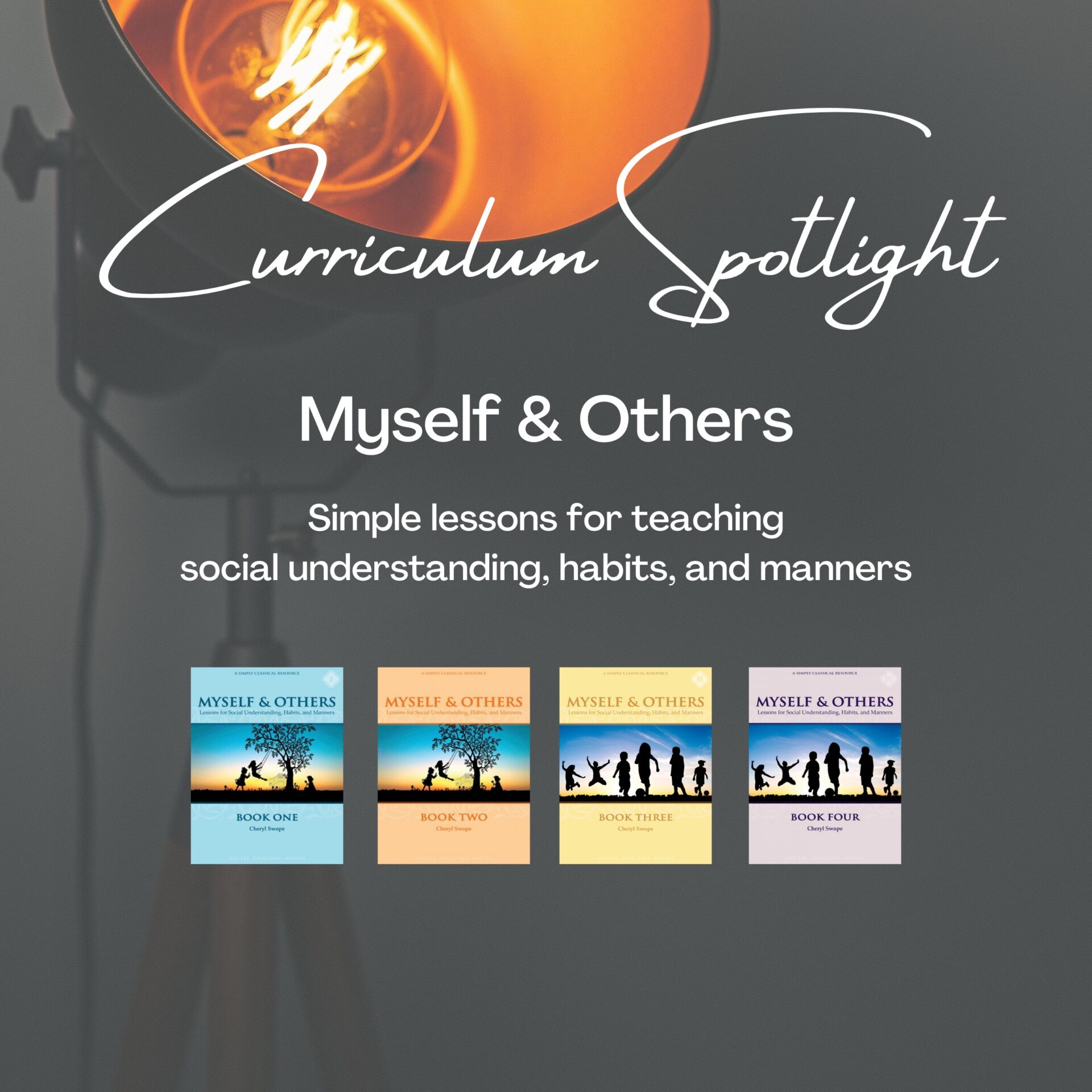
What About Socialization? There is one question that is guaranteed to get a response from a homeschooling parent. It goes something like this: What about socialization? What follows is usually an entertaining conversation. Asking a homeschooling Mom about socialization is like asking an alien about extra-terrestrial life. We live with these tiny humans. All we do is socialize them. Just don’t get us started. Reactive or Proactive? In truth though, there is a tiny molecule in our brains that doubts our confidence. Are they really socialized? Do they really have the social habits and behaviors that are acceptable in public? I would suggest that they do, but only because we’re actually really self-conscious about this subject. We react more than we act, and when we see our children behave in a way that is not sensitive to their surroundings we will follow up and teach them after the fact. But we don’t have to react. We could be proactive and know what it is that we need to teach our children about habits and behaviors that are respectful to our fellow humans. This is how the curriculum Myself and Others can help. This program addresses subjects that we know we want to teach to our children, but we don’t think about it until it’s too late. Add Read-Alouds This program starts with the very basics by helping a child to understand what he or she is feeling. What does it mean? How shall the child respond? If you just do the core program you will be so blessed with the topics that are addressed. But if you are able to add in the read alouds, then the richness of manners really displays itself. For example, there is no better work on friendship and the fruit of kindness than Winnie-the-Pooh. Loyalty shows up in Rikki-Tikki-Tavi, and diligence in The Little Red Hen. Children might understand rules, but they definitely understand stories. As they travel with Miss Rumphius, scattering beauty wherever she goes, they will see the truth of how kindness and generosity extend beyond our actions and bless others after we are gone. Teach Them to Love After four programs, children will have a good idea of how to conduct themselves in a way that not only shows love to their neighbors, but also honors God, and reflects His design for our lives. After all, one of the greatest commandments is to love your neighbor as yourself. Knowing how to control our bodies, minds, and thoughts is right up there in loving those around us. Quick facts: This can be done with special needs children too. You can purchase the guide alone for plenty of ideas and tips. The books with the core sets enhance and illustrate the ideas. The read-aloud packages are optional, but they both help you as the parent to see where to guide discussion and they are excellent stories to guide the child’s moral imagination even if you never get a chance to discuss a word of them. by Hester VanBraeden Hester is a second-generation home-educating parent who is keenly aware that her own education is not complete, and comfortable that it probably never will be. She has many years of experience with children, books, and curriculum. She loves to travel to worlds and times beyond the present with her children through many books. Hester and her husband have four children and live in the lower mainland of BC.

Five Little Peppers and How They Grew Heidi Old Mother West Wind The Hundred Dresses Chu Ju’s House Archer and Zowie The Penderwicks The Boxcar Children Charlotte’s Web Beezus and Ramona Cupid and Psyche

The more I read, the more I want to read and realize that I will never get through my list. That doesn’t stop me from reading, but sometimes I wonder if my time is spent wisely on one text versus another. This is particularly true about the literary canon where I want to read every single word. But even if I knew where to start, I would never get through it all. And I’m sure it would only make me ask more questions as I wonder about context and relationship to other texts that are not included in the literary canon. The perfect solution to this problem would be a tutor or a guide to help me navigate that great and worthy body of thought. That is why I get pretty excited about Old Western Culture and the program that they have created. They feature the esteemed Dr. Wes Callihan, an approachable, wise teacher who has extensive insights and knowledge into the Great Books. In these lectures, he comfortably approaches each topic from his leather armchair, ceding the screen for the occasional picture or piece of art that illustrates his point. He shares with us his knowledge of the text and how it integrates with the rest of the humanities, and he shows us how these works echo through history and thought turns to action. Later units include other presenters, but it’s hard to improve on Dr. Callihan’s friendly expositions. Curriculum Overview In this program, the Great Books of Western Culture are split into four different eras: The Greeks, The Romans, Christendom, and Early Moderns. Each era is divided again into four parts, each part dealing with an aspect of the era equalling a total of 12 units. The Great Books will be covered, but only excerpts will be selected as required reading. You can be sure those are the excerpts that are worth your time. DVDs The lectures, or rather, delightful monologues as I like to call them, are presented on DVDs with 12 lectures per DVD. Readers There is required reading for each lecture which is where the Readers become very handy. The Readers for each unit are the selected readings all compiled into one volume. Sure, you could buy the individual works of Augustine, Anselm, or Aquinas. But you could also buy just the one volume published as the Reader for each unit which will contain all the required reading. If you’re like me that will save time both in hunting down texts and organizing them so you can find them when you need them. Workbook Finally, if you want to engage with the content you can purchase the workbook applicable to each unit which will help you to ask questions and further digest the content. Adaptability It’s easy to look at this entire program and get overwhelmed once again. Even bite-sized lessons, when piled high can look like a mountain. Yes, it’s nicely organized and arranged, but even this is a commitment beyond our ability. It’s our dream to have each of our kids do something like this program during their high school years, but what if we are homeschooling from one year to the next? What about wanting to do this for ourselves so we can at least engage with our teenagers on these issues? I suggest that we don’t let those questions hold you back. This program is perfectly organized, as we established, so maybe you need to take it one unit at a time. Pick something you want to learn. Is it Nicene Christianity? Poetry and Politics in the Modern Era? Or the writings of the Reformation? Even one of these units would be an amazing course. Maybe you can find time for two. Three? It’s possible. We could even take this further. This doesn’t need to be about your homeschool or your own education. This could be a unit study for your youth group at Church. Or a study group with other adults. This is a fully credited high school course, but it can be anything you want it to be. Each of us wishes we could have the education that our children will have. Well, I’m suggesting that we don’t have to wish any longer. We can start right here. It’s only 12 units, and a good time with our teenagers as we learn together in community with our Church, our homeschool group, or just as a family. Quick facts: Each unit includes a DVD, Reader, and Workbook. You don’t need to do the workbook. An option is to just watch the DVD. Watch reviews on Youtube of Dr. Callihan’s teaching style here. This is not a four-year commitment. It is only a commitment to one unit (and then the next…). The Readers provide easy access to the text. The Workbook completes the program as a course for high school. Each lecture is around 30 minutes long. by Hester VanBraeden Hester is a second-generation home educating parent who is keenly aware that her own education is not complete, and comfortable that it probably never will be. She has many years of experience with children, books, and curriculum. She loves to travel to worlds and times beyond the present with her children through many books. Hester and her husband have four children and live in the lower mainland of BC.
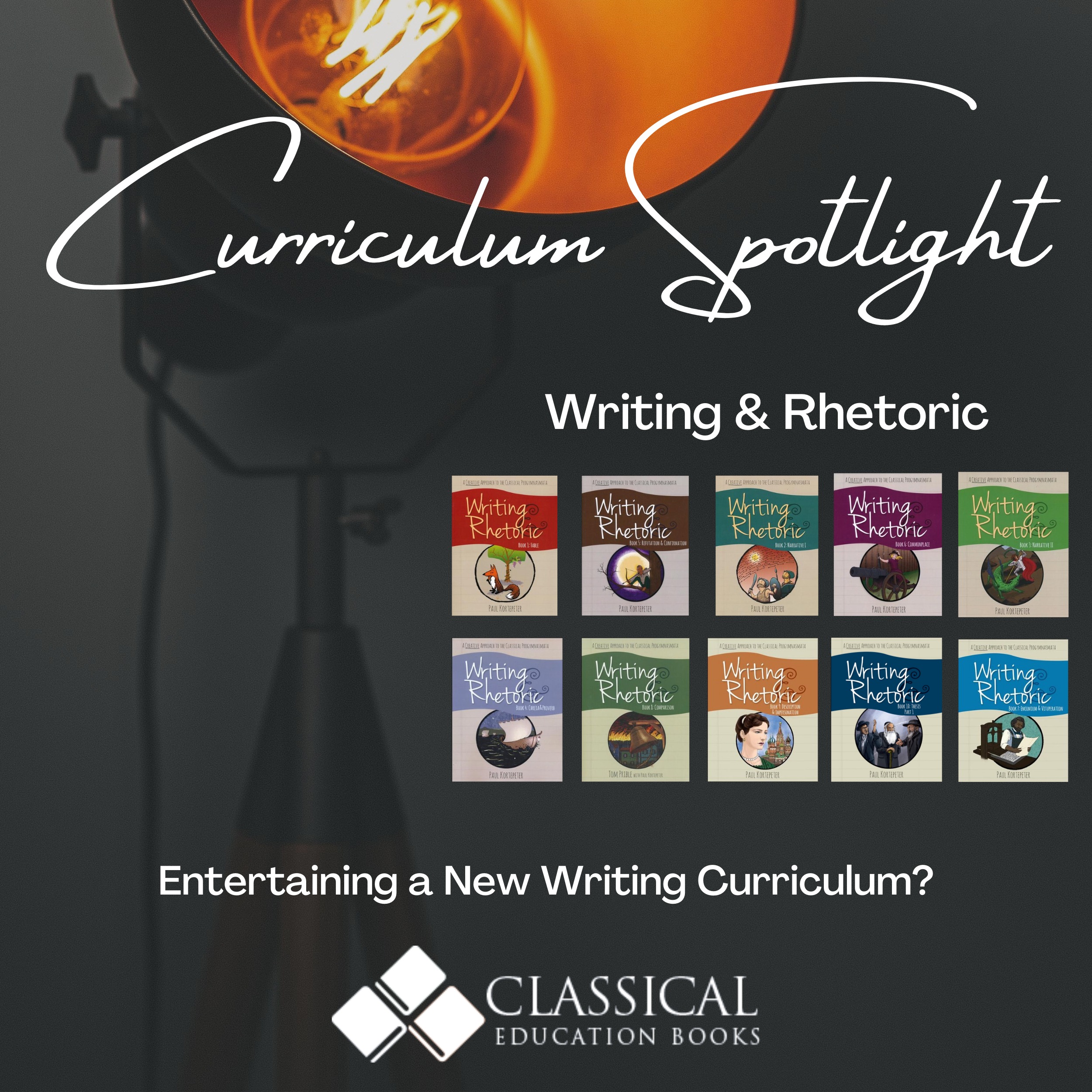
Common Writing Challenges There is no tyranny like the blank page, or so the saying goes. If you have taught writing you know that look. The eyes glaze over, heavy sighing ensues, and the pencil drops on the page. What shall we write about? Where shall we start? It is difficult to ask a child to write about something when they don’t have much to fall back on for content. Another Approach What if we did not ask a student to “write something, anything!” Instead, spend our time with them reading good stories, fables, poems, and other works that others have written. We tell these stories back to each other, both in summary and with dramatic flair. We spend time understanding the story, and then, while the words are flowing through our minds, pull out the pencil and paper and start transferring thoughts to paper. This is the basic idea behind the program Writing and Rhetoric by Classical Academic Press. Writing and Rhetoric starts with Fables. It helps the child to collect their thoughts by narrating passages back which is the initial stage of rhetoric. By filling a child with stories, vocabulary, phrases, the child is learning not only how to write, think and speak, but they will also have a rich body of literature to draw ideas from. If imitation is the highest form of flattery, then Writing and Rhetoric does a fine job of flattering great literature. Quick facts: Recommended to start with Book 1 in Grades 3 or 4 You can start later. Grades 4-5 start with Book 3. If the student can already identify the “5Ws (who, what, when, where, why)” start at Book 5. Each book covers one semester, so a student is expected to complete two books per year One semester of books is simply a Student Book and a Teacher’s Edition You can purchase .mp3 files from CAP that include jingles of the memory work Teacher’s Editions are open and closed lesson plans. This program will take your student through Grades 8-9 and have them ready for Logic and Rhetoric It can be taught to one student or a class of students Includes narration and memorization Progresses from basic storytelling to writing persuasive essays to deliver eloquent speeches. If done along with Well-Ordered Language the student will learn grammar by imitation as well. by Hester VanBraeden Hester is a second-generation home educating parent who is keenly aware that her own education is not complete, and comfortable that it probably never will be. She has many years of experience with children, books, and curriculum. She loves to travel to worlds and times beyond the present with her children through many great books.

My family has a New Year’s Eve tradition where we write a letter to our future selves. We open it a year later, on New Year’s Eve. It’s fun but sometimes discouraging. I’ve learned that writing a list of goals as a motivational tool can fall flat as you read through the list the following year, only to discover you haven’t accomplished much. Today, I’m writing a letter to my past self, a dear young mama. There is so much I’d like that young mama to know and my hope is that it can make a difference for you. Dear Young Mama, You are struggling to make a decision about whether to homeschool your children or to enroll them in public school. There are many things to consider but here is the truth. It will be easier to send your children to school if you decide that homeschooling isn’t a good fit than it will be to pull your children from school if you decide that school isn’t a good fit for you. Consider finances. I know the plan is for you to go back to work once your children are school age but the finances are going to be there as you need them. The Lord is going to provide and it’s going to be faith building to see how He does it. You are going to have to budget, there will be sacrifices, and lean times but there will also be amazing financial surprises along the way. Start today by praying for financial wisdom. Ask the Lord to reveal to you any financial beliefs, desires, and habits that are contrary to His word. Spend the needed time uprooting financial idols. Confess the worldly desires of your heart, He knows what they are anyway. You will need His grace to change, you can’t do it in your own strength. Once you have started to work on your heart, you need to implement some tools. Start by writing out a budget and then figure out a system to keep track of the spending. There is no need to buy a program for this, pen and paper will work just fine but I am a fan of YNAB (You Need A Budget). Take some time to figure out exactly what your husband makes per hour (after income tax and all the other deductions). This will help you when you are tempted to spend beyond what is needed. Ask yourself in that moment, “Is this item worth my husband having to work X amount of hours for us/me to have this?” Finally, figure out what you can do to earn some “Proverbs 31” income. The size of this endeavor will depend on the time and energy you have, the level of responsibility your husband has at his job, and the amount of home and family responsibilities that he’s able to take on. But please realize that even if you can only earn and save $100/month, it will richly bless your family 20 years from now. Consider relationships. Your friend group is going to change and not all family members are going to be supportive of homeschooling. Don’t worry, you are going to meet heaps of incredible families and you’ll meet your most treasured friend amongst those families. Try to remain quietly confident and strong-minded but tender-hearted towards the critics. The fruit grows slowly, be patient, they’ll start to see. Don’t consider whether you are smart enough. Others will question and you’ll wonder if you are smart enough to homeschool your children. Don’t waste your time pondering this question. There will be an incredible variety of curricula for you to choose from that will help you educate your children. Many people have gone before you and they will be a blessed resource. Ask lots of questions, take notes, don’t be afraid to tweak the advice to fit you and your family, and twenty years from now you’ll be writing a blog post encouraging mamas with your own thoughts. Consider your priorities. Develop a firm grasp of what your priorities are. Build a habit of being in the Word daily, become a prayer warrior, and worship, and serve on a regular basis. Make your husband your next priority. It’s a mistake to neglect this relationship and it’s so easy to do. Next in line are the children. It can get tricky here as you figure out how to serve the Lord as both a dear young mama and teacher to your children; mama should show up first. Consider how you will organize. If you have a kitchen table, then you have space to educate your children. What you will need are bookshelves. I’ve yet to go into a homeschooling home that doesn’t have walls full of books. Homeschool mamas develop a special relationship with books so get yourselves some bookshelves. Paper! There is so much paper. It enters your house in many forms: workbooks, worksheets, journals, creative writing, reports, printables, artwork, and more. Spend some time thinking about what you are going to keep and how you are going to store it. Do Not, I repeat, Do Not buy a plastic bin to store all the paper thinking that you’ll get to it another day. Consider time. Theatre Class Dance Class Creative Writing Class Art Class Self-Defence Class Martial Arts Soccer Football Baseball Basketball Hockey Gymnastics Homeschool Co-op Youth Group Swimming Lessons Skating Lessons Outdoor Club Archery Field Trips There is no shortage of good things to participate in. Take time to create a vision and some boundaries regarding how you will spend your time and then make decisions that align with your vision and boundaries. Dear young mama, don’t ever consider that homeschooling will save your children. There is no checklist or formula that ensures your children will become followers of Christ. If there were, you would be owed the glory for the salvation of your children. Homeschooling will protect your children from worldly influences for a time, but it won’t protect
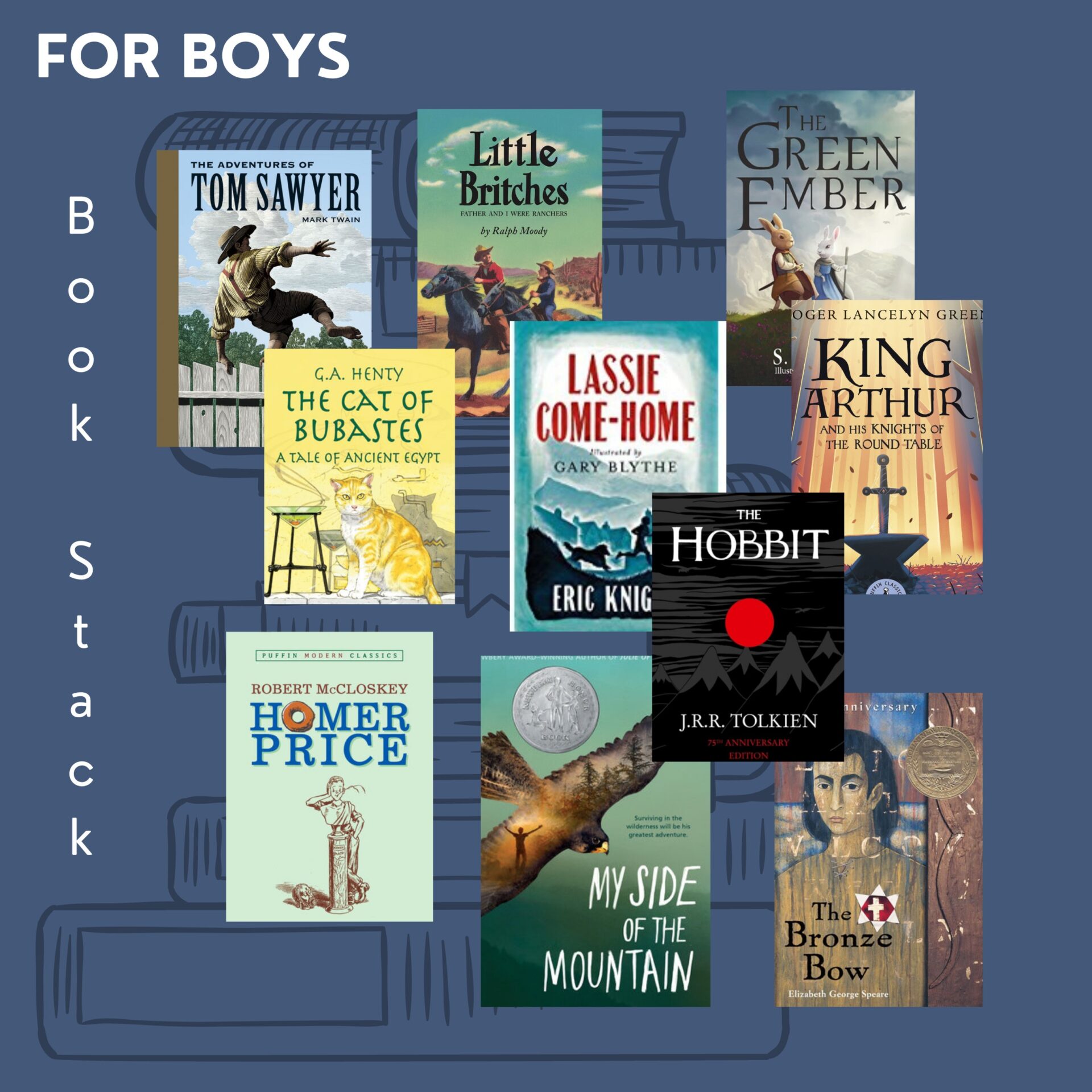
Send the boys in your life on an adventure with these books. Visit a graveyard with Tom Sawyer, battle wolves in The Green Ember, or run away to Catskill Mountains in My Side of the Mountain. If you have a reluctant reader then head off on the adventure with him and try a read-aloud. Get caught up in the emotions of Lassie Come-Home, travel back in time to Egypt in The Cat of Bubastes, or maybe you want to spend some time in the fantasy land of Middle Earth in The Hobbit. What’s left? King Arthur, Little Britches, The Bronze Bow, Homer Price. You could order a few copies of the same book and try a book club. by Adrianne Curwen Adrianne is a wife to a public-school educator/administrator and a homeschooling Mama to seven children, ranging in age from 7 to 23. She believes that we have a unique opportunity as homeschoolers to design individualized education that suits giftings, interests, and passions. She and her husband have used a blend of registered homeschooling, enrolment with independent DL schools, and participation in public trade school programs to design individualized programs for their children. She is passionate about using as many read-alouds, picture books, novels, and conversations to educate her children but also gets excited by the amazing homeschool-designed curriculum that’s out there. Adrianne is thrilled by her new role as Communication Specialist for Classical Education Books and is grateful to have an opportunity to learn something new. She is grateful, every day, for her saviour, Jesus Christ, and has no greater joy than when she sees her most important missions field walk with Him.
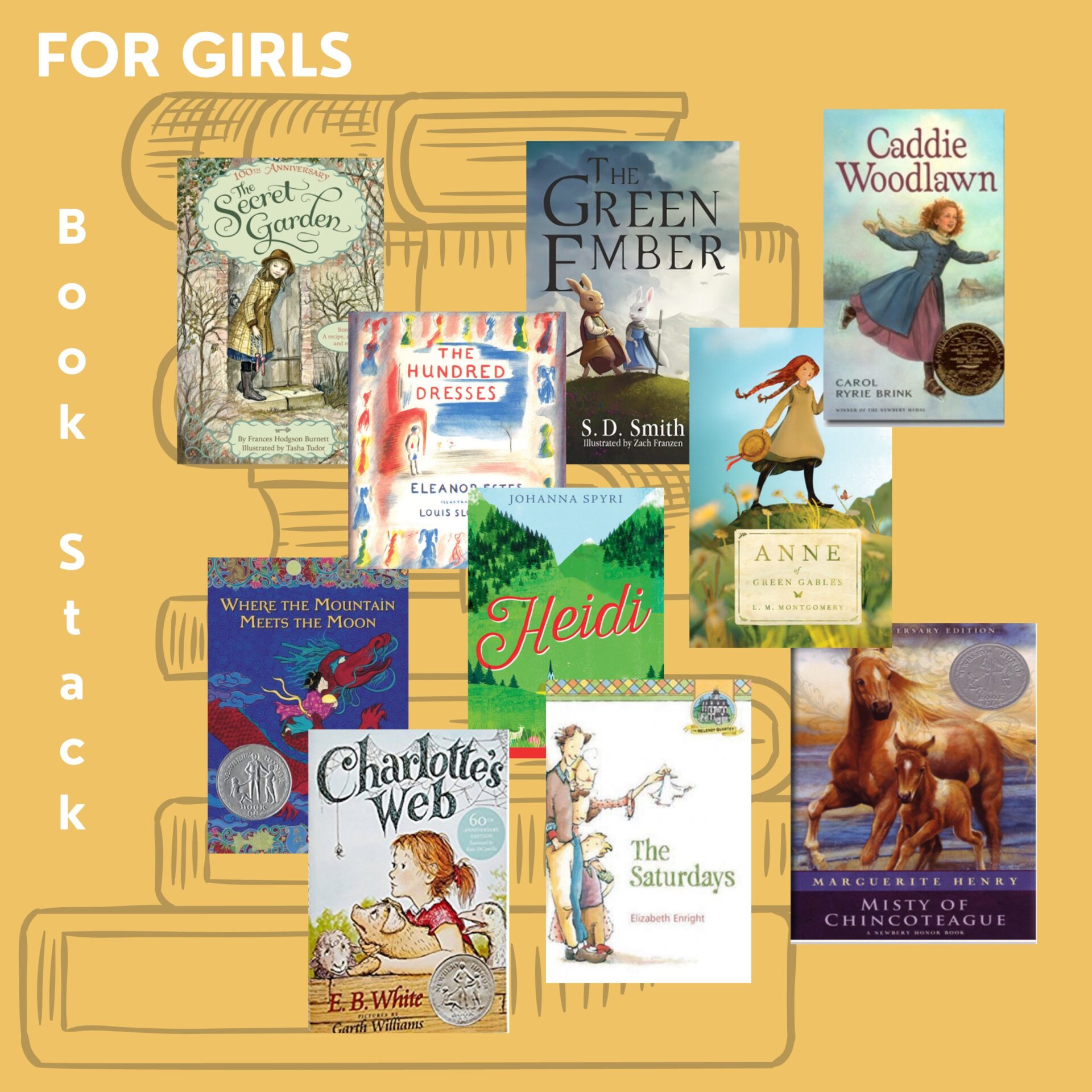
Books have much to offer our girls. These titles are packed with adventure, life lessons to explore, emotions to face, and new things to learn. Embark on a conversation about how we should treat others and the regret that follows when we don’t do the right thing, as you read The Hundred Dresses. Introduce your daughter to another culture in Where The Mountain Meets the Moon. And have fun with Caddie Woodlawn as you travel back to the 1860s. Is your girl all about horses? Then you need to get your hands on Misty of Chincoteague. I have a girl that was so intrigued by the fact that she kept forgetting Heather was a rabbit in The Green Ember. Meet the Melendy children in The Saturdays as they come up with a clever way of getting the most out of their Saturdays. Or how about planning a girl’s movie night? Don’t forget to read the book first. You have a few to choose from: The Secret Garden, Heidi, Anne of Green Gables, and Charlotte’s Web. by Adrianne Curwen Adrianne is a wife to a public-school educator/administrator and a homeschooling Mama to seven children, ranging in age from 7 to 23. She believes that we have a unique opportunity as homeschoolers to design individualized education that suits giftings, interests, and passions. She and her husband have used a blend of registered homeschooling, enrolment with independent DL schools, and participation in public trade school programs to design individualized programs for their children. She is passionate about using as many read-alouds, picture books, novels, and conversations to educate her children but also gets excited by the amazing homeschool-designed curriculum that’s out there. Adrianne is thrilled by her new role as Communication Specialist for Classical Education Books and is grateful to have an opportunity to learn something new. She is grateful, every day, for her saviour, Jesus Christ, and has no greater joy than when she sees her most important missions field walk with Him.
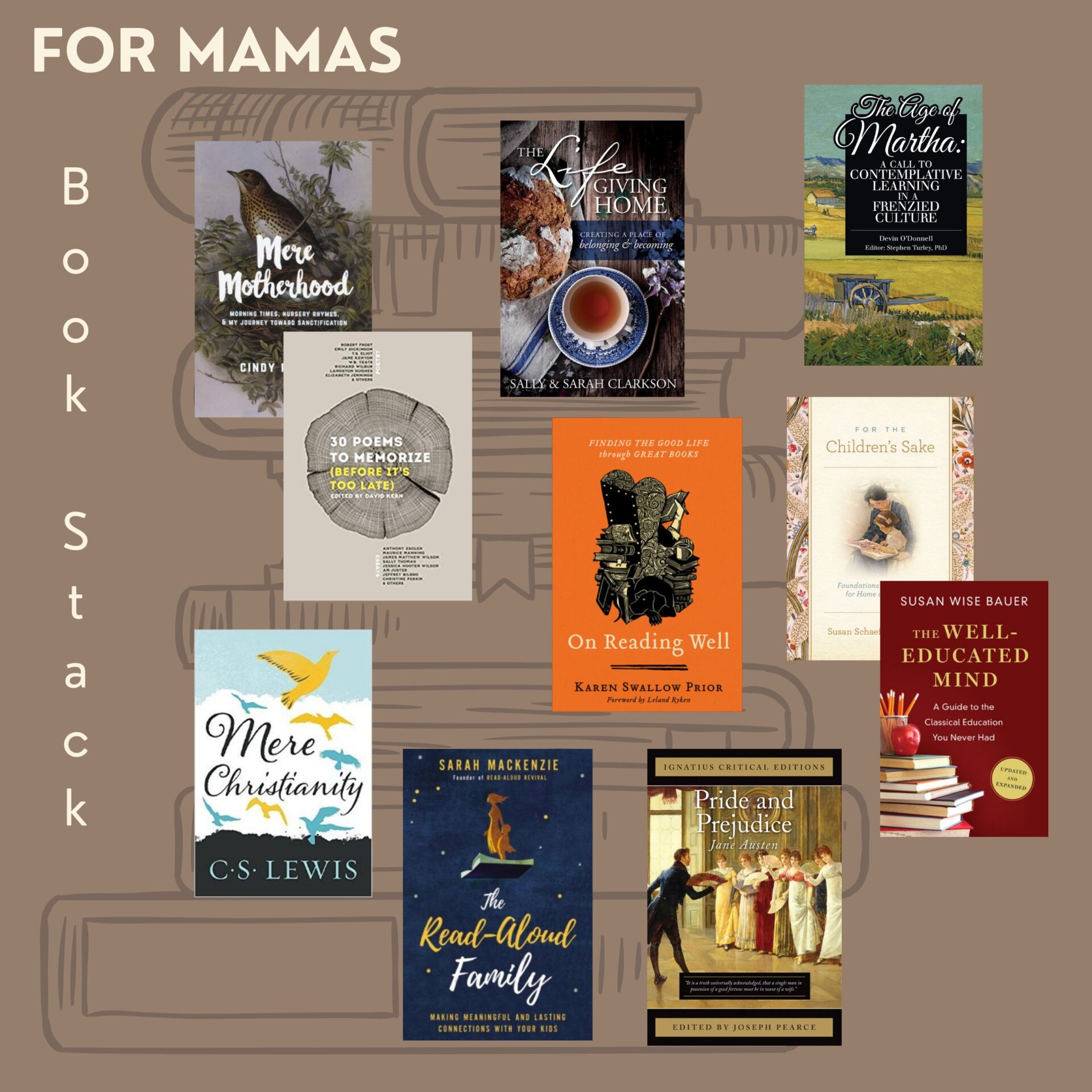
Keep-er /ˈkēpər/ 1. a book that has worn edges, dog-eared corners, and pencil markings because it has been poured over many times similar meanings: treasure trove, gold mine, cache The books listed here are all keepers. Many of them should probably just remain in your “to periodically review” pile as there really is too much to be mined during the first read-through. Mere Christianity is a Christian classic and Pride and Prejudice is a literary classic. Don’t miss out on either of these. For the Children’s Sake is an educational classic and is a title commonly seen on recommended reading lists for homeschooling mamas along with The Well-Educated Mind. Other titles that are sure to inspire you on your mothering and homeschooling journey are Mere Motherhood and The Life-Giving Home (on my personal wishlist). Pick up a copy of 30 Poems to Memorize or On Reading Well and you’ll be encouraged to fill your mind with beautiful things. In Age of Martha, you’ll be challenged to rest, allowing time for contemplation. Finally, amongst all the moving parts of a homeschooling family, you’ll never regret the time you spend reading aloud to your children. The Read-Aloud Family will help you get started or revive you whether you have toddlers or teenagers. by Adrianne Curwen Adrianne is a wife to a public-school educator/administrator and a homeschooling Mama to seven children, ranging in age from 7 to 23. She believes that we have a unique opportunity as homeschoolers to design individualized education that suits giftings, interests, and passions. She and her husband have used a blend of registered homeschooling, enrolment with independent DL schools, and participation in public trade school programs to design individualized programs for their children. She is passionate about using as many read-alouds, picture books, novels, and conversations to educate her children but also gets excited by the amazing homeschool-designed curriculum that’s out there. Adrianne is thrilled by her new role as Communication Specialist for Classical Education Books and is grateful to have an opportunity to learn something new. She is grateful, every day, for her saviour, Jesus Christ, and has no greater joy than when she sees her most important missions field walk with Him.
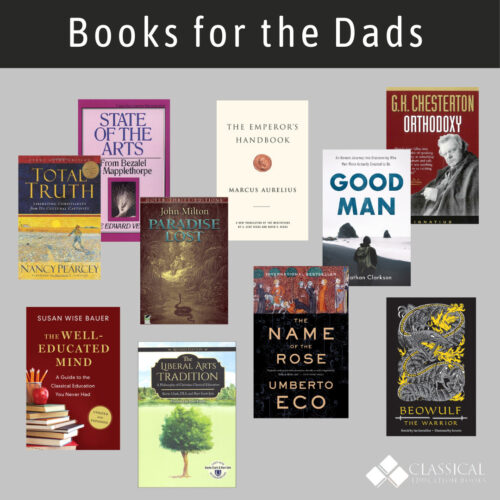
Many fathers are out of the house, working during the day, leaving the Moms to do the lion’s share of the homeschooling. It’s a setup that often makes sense but a father’s involvement is a blessing to his wife and children so we’ve selected a stack of books to help. There is something here for all dads. A few of these books will take you back to glean the timeless wisdom from writers who lived before you. Beowulf the Warrior is the retelling, in modern language, of a fictional classic, it would be a great one to start as a read aloud. The Emperor’s Handbook is a translation of Marcus Aurelius’ meditations. Major themes include character, leadership, and duty. You could explore the meaning of life in the 17th-century classic, Paradise Lost, or sink your teeth into G.K. Chesterton’s, Orthodoxy. Are you looking for something more specific to homeschooling? Try The Liberal Arts Tradition or The Well-Educated Mind. The Name of the Rose is part historical fiction, part mystery, and part theology; a fictional piece that challenges. If you are looking for something to fulfill the pragmatic side then try State of the Arts, Total Truth, or Good Man. Undecided? The links will take you to a full description of each title. by Adrianne Curwen Adrianne is a wife to a public-school educator/administrator and a homeschooling Mama to seven children, ranging in age from 7 to 23. She believes that we have a unique opportunity as homeschoolers to design individualized education that suits giftings, interests, and passions. She and her husband have used a blend of registered homeschooling, enrolment with independent DL schools, and participation in public trade school programs to design individualized programs for their children. She is passionate about using as many read-alouds, picture books, novels, and conversations to educate her children but also gets excited by the amazing homeschool-designed curriculum that’s out there. Adrianne is thrilled by her new role as Communication Specialist for Classical Education Books and is grateful to have an opportunity to learn something new. She is grateful, every day, for her saviour, Jesus Christ, and has no greater joy than when she sees her most important missions field walk with Him.


